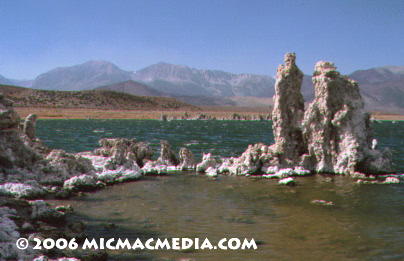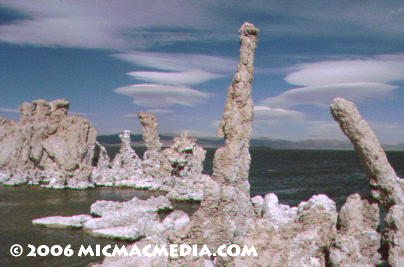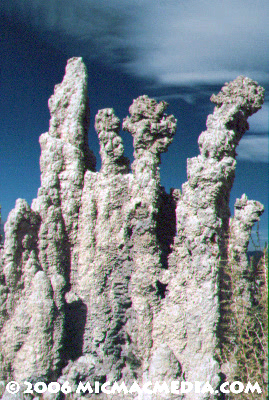|
Tahoe Nugget #96:
Magical Mono Lake
October 18, 2006
I'm taking a "working vacation" the next few days, driving down Highway 395 to spend some time in Bishop, California. Although I have plenty of work to do, I'll enjoy the sunny, relatively warm days
(70s) taking short hikes, exploring and photographing the spectacular terrain. Even though Lake Tahoe is a beautiful spot, every so often I crave the exotic landscape along the eastern Sierra Front. October is one
of the best times of year to go; crowds are gone, but the High Country is still open (there is some fresh snow up there since we've had a couple of winter-like storms recently).
On the drive south, one of
the places I always stop to see is Mono Lake, a majestic body of water covering 60 square miles; 13 miles east-west by 8 miles north-south. The lake, located near the little town of Lee Vining, is ancient. In
existence for more than 760,000 years, it's one of the oldest lakes in North America. Water in Mono Lake is 2.5 times as salty as seawater, which makes swimming a delightfully buoyant experience (once you get
over the slimy mud and muck along the shoreline and lake bottom as you enter the water). The lake has high salt concentrations, but it is teeming with life. You won't be catching any trout or sport fish in Mono
Lake, but the brine shrimp and alkali fly larvae are an important part of the food web for millions of birds as they pass through on their migratory flights along the Eastern Sierra.
The Native Americans who
lived in the Mono Basin, the Kutzadika'a (Mono Lake Paiute), collected the abundant fly pupae that thrive there as a food source. Other tribes, who traded acorns for the nutritious larvae, called the Kutzadika'a the Monache, meaning "fly-eaters." Yum! Monache was shortened to Mono and applied to the region and the people living there by early explorers in the 1850s.
Another interesting aspect of the lake's unique landscape are the tufa towers that have formed there. The strange spires and knobs are formed when fresh water springs containing calcium bubble up through the carbonate-rich lake water. The combining of these waters forms calcium carbonate, a whitish limestone deposit that forms the basis of the tufa formations. The tufa formations can tower 15 feet or more due to historic lake level fluctuations. Although the setting is spectacular (the lake is surrounded on three sides by volcanic formations), Tufa is not unique to Mono Lake, it is found in many alkaline lakes throughout the world.
Photo #1: Looking west over Mono Lake toward Sierra
Photo #2: Lenticular clouds form over Mono Basin
Photo #3: Tufa towers can exceed 15 feet in height



|





